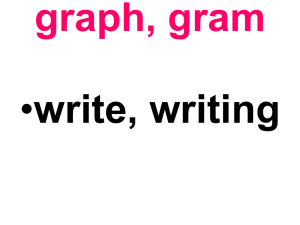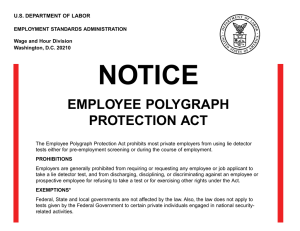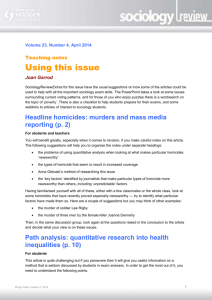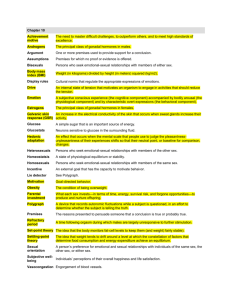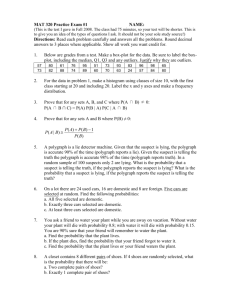CHAPTER 1 INTRODUCTION 1.1
advertisement
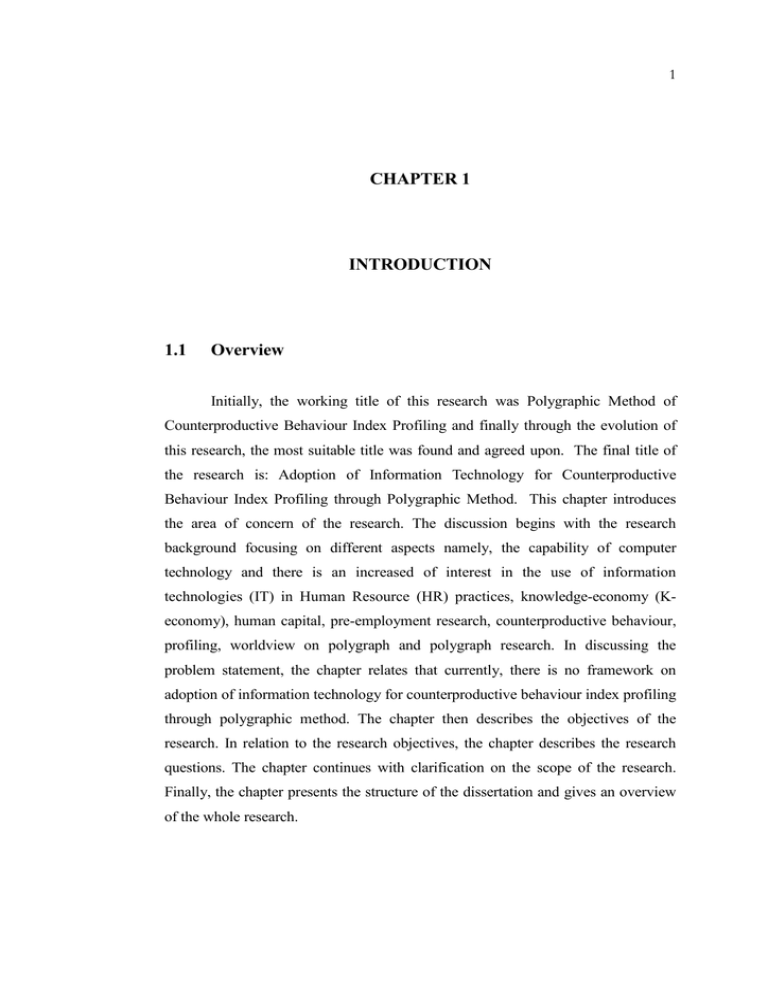
1 CHAPTER 1 INTRODUCTION 1.1 Overview Initially, the working title of this research was Polygraphic Method of Counterproductive Behaviour Index Profiling and finally through the evolution of this research, the most suitable title was found and agreed upon. The final title of the research is: Adoption of Information Technology for Counterproductive Behaviour Index Profiling through Polygraphic Method. This chapter introduces the area of concern of the research. The discussion begins with the research background focusing on different aspects namely, the capability of computer technology and there is an increased of interest in the use of information technologies (IT) in Human Resource (HR) practices, knowledge-economy (Keconomy), human capital, pre-employment research, counterproductive behaviour, profiling, worldview on polygraph and polygraph research. In discussing the problem statement, the chapter relates that currently, there is no framework on adoption of information technology for counterproductive behaviour index profiling through polygraphic method. The chapter then describes the objectives of the research. In relation to the research objectives, the chapter describes the research questions. The chapter continues with clarification on the scope of the research. Finally, the chapter presents the structure of the dissertation and gives an overview of the whole research. 2 1.2 Background of the Research Computer technology makes possible the continuous collection and analysis of management information about work performance and equipment use. This information can be useful to managers in managing resources, planning workloads, and reducing costs. It can be advantageous to employees as well, by providing timely feedback on performance and an objective basis for evaluation. Despite these possible advantages, however, there is controversy about computerbased monitoring on grounds that it invades employees’ privacy, causes stress, and can be used unfairly by some employers. Advances in technologies have had a profound impact on the business practices of many organizational functions including financial systems, sales, marketing, and production. Recently have we seen an increased interest in the use of information technologies (IT) in Human Resource (HR) practices such as personnel screening and selection. For example, Nike uses Interactive Voice Response (IVR) technology to screen applicants over the telephone, followed by computer-assisted interviews with selected applicants, and finally performs faceto-face interviews (Thornburg, 1998). Other organizations, such as Home Depot, BI-LO, JC Penny, and the US Department of Defense, use a variety of technologies for screening and selection, such as the telephone, IVR, and computer adaptive testing (Frost, 1997). Commercial applications designed to screen resumes for keywords are also widely available to organizations. Although the potential for technology use is vast, researchers and practitioners know surprisingly little about the array of technologies being used in organizations or the extent to which these technologies are being used to recruit, screen and select employees. We want may to examine the extent of technology use across the various stages of recruiting and selection including: (a) advertising positions, (b) receiving applications, (c) initial screening, and (d) final selection. In addition, we wanted to determine the extent to which HR departments used 3 these technologies for staffing: (a) low-level or entry-level positions, (b) mid-level positions, and (c) high-level positions. There is an increased of globalization of the economy and labour market. To succeed in a competitive global marketplace, businesses are looking for the best and brightest employees, regardless of their geographical setting. However, searching the international marketplace for talent is an expensive enterprise. Many organizations are discouraged by the costs involved and others are forced to pay rather than risk losing business as a result of a shortage of skilled workers. The use of IT in screening and selecting applicants has the potential to significantly reduce costs while simultaneously expanding applicant pools (Cummings, 1993; Thornburg, 1998). Kroeck and Magnussen (1997), for example, found that organizatons who were initially unwilling to travel to smaller or geographically distant universities were able to do so by using videoconference technology to conduct their interviews. The emergence of a knowledge-based economy (K-economy) has spawned a “new” notion of workplace literacy, changing the relationship between employers and employees. The traditional covenant where employees expect a stable or lifelong employment will no longer apply. The retention of employees will most probably be based on their skills and knowledge that can create advantages for the company over its competitors. Employers invest in the skills of their employees to improve productivity and the profitability of the company. Training costs can be substantially higher than that of general or academic education but are justified when the value of the company’s earnings and productivity exceed the cost of the training. Numerous empirical studies regarding entry-level employee competencies from the perspective of employers have been conducted in both industrialized and developing nations. The results of the studies found that employers prefer certain types of entry-level competencies of the prospective employees (Mustapha & Abdullah, 2000). 4 Research has shown that employers perceive technical competency as critical workforce literacy. Communication and interpersonal skills are also essential. Other skills include critical and problem-solving skills, self-motivation, and management skills. However, to compete and survive in the era of a K-economy and globalization, a new set of workplace literacy is deemed necessary. The k-economy requires knowledgeable, skilled, dynamic, creative, and innovative human resources (Mustapha & Abdullah, 2000). In addition, the new global market calls for visionary leadership and the adoption and application of new management and organizational principles. Employers need to recruit more “knowledge” workers for higher skills jobs. Security issues in any employment include finding the right human capital. Finding the right people for the right job involves pre-employment screening. Profiling is an investigative technique and forensic science with many names and a history of being practiced on many levels for many years. It is extensively represented and glamorized in books and film. It is most commonly associated with law enforcement, although profiling takes place in other areas and in other contexts not limited to criminal justice (Harris 2002; Bumgarner 2004). Choosing the right people, whether it’s recruiting or promoting them, is fundamental to the success of any organisation. Wrong selection decisions can make for unnecessary financial outlays and waste a great deal of time and other resources. Security issues in any employment include finding the right human capital. Finding the right people for the right job involves pre-employment screening. In order to help detect counterproductive behaviours, various techniques have been utilised including the methods and techniques of using pencil and papers methods and polygraph. Based on the American Polygraph Association (APA) with over 2500 members worldwide, the polygraph is currently the most accurate method available 5 for truth verification (APA, 2000). APA has a compendium of research studies available on the validity and reliability of polygraph testing. The 80 research projects listed, published since 1980, involve 6380 polygraph examinations or sets of charts from examinations. Researchers conducted 12 studies of the validity of field examinations, following 2174 field examinations, providing an average accuracy of 98%. Researchers conducted II studies involving the reliability of independent analyses of 1609 sets of charts from field examinations confirmed by independent evidence, providing an average accuracy of 92%. Researchers conducted 41 studies involving the accuracy of 1787 laboratory simulations of polygraph examinations, producing an average accuracy of 80%. Researchers conducted 16 studies involving the reliability of independent analyses of 810 sets of charts from laboratory simulations, producing an average accuracy of 81%. Withstanding more than a century of research, development and widespread use, the polygraph test remains the most effective means of verifying the truth and detecting deception. The most accurate instrument currently used for truth verification is the polygraph (Gordan, N.J, Fleisher.W.L., 2010). Polygraph tests are currently used in criminal investigations in many countries including Belgium, Canada, Israel, Japan, Turkey, Singapore, South Korea, Mexico, Pakistan, Philippines, Taiwan, Thailand and USA (Lykken, 1998, Raskin, 1990, Vrij, 2000). Law enforcement and intelligence agencies in US, have long maintained that polygraph is a useful tool. In terms of employee screening, the threat of a polygraph test may deter employees from engaging in illicit activities (BPS, 2004). Law enforcement in Malaysia namely Anti-Corruption Agency since 1995 and Royal Malaysia Police has started using polygraph since 1996 (Kiang, 1996). High security risks and high integrity risks organizations require the appointments of personnel to important key positions to be conducted in a stringent manner with many levels of screening to determine the best person with the best integrity for the right job. Polygraph tests have become a widely used instrument in 6 many developed countries for the last phase of the pre-employment or promotion exercise to determine counterproductive behaviour tendencies. There are problems in current situation. Current polygraph tests are very expensive and time consuming to conduct. Furthermore, it requires certified polygraph examiners and special instruments to conduct the tests. There are very limited numbers of certified polygraph examiners in Malaysia. There are nine (9) in Malaysia and worldwide there are over 2500 certified polygraph examiners. The questions posed during the polygraph examinations are in English. Non validated questions posed in other languages to native subjects or examinee as claimed will contribute to inaccuracy. Improper reading of the paper charts of polygraph testing caused misinterpretation of the results. Globally, it is also not practical to keep paper charts as a means of data keeping to keep historical data and profiles. Whilst polygraph is being developed in the western countries for about 100 years, it is most suited to the westerners. The development and advancement of polygraph in the western countries, invites the people in the eastern countries to utilize it. Japan, Singapore, South Korea, Pakistan, Philippines, Taiwan, Thailand and Malaysia has started using polygraph the western version in pre-employment and criminal investigations. The integration of information technologies and usage of polygraph in eastern countries demands the attribute to be in multilingual due to broad based multiracial communities in the eastern countries. 1.3 Problem Statement Up until now, the majority of integrity tests used as part of the selection process centred around two major types of solutions: self-report pencil and paper/online and polygraph (lie detector test - change in individual's physiology in response to the emotion of fear) integrity tests. 7 Polygraph has often been accepted as a highly valid instrument in assessing honesty in the work area. To date, there have been only a limited number of research projects on the accuracy of polygraph testing in the pre-employment context, primarily because of the difficulty in establishing ground truth. However, since the same physiological measures are recorded and the same basic psychological principles may apply in both the specific issue and pre-employment examinations, there is no reason to believe that there is a substantial decrease in the accuracy rate for the pre- employment circumstance. The few studies that have been conducted on pre- employment testing support this contention. While the polygraph technique is not infallible, research clearly indicates that when administered by a competent examiner, the polygraph test is one of the most accurate means available to determine truth and deception (APA, 2000). Research through readings and analysis was done on all the polygraph journals and magazine published since 1972 by American Polygraph Association (APA) including the policies and guidelines, it was found out there was no clear framework on pre-employment or employment screening or adoption of information technology on framework of pre-employment or employment screening. In conducting pre-empolyment personnel selection by human resource executive, what method can be used to utilize polygraph charts? Polygraph have undergone various development and advancement in term of information technology so as to meet the current demand. Currently, according to initial study and up untill now, index profiling using polygraph method has not been done. Hence the problem statement is as follow: There is no framework that can be utilised for adoption of information technology for counterproductive behaviour index profiling through polygraphic method. 8 1.4 Research Questions Based on the problem statement and literature review done, it was formulated that the research question for this research is as follows: What framework can be utilized for adoption of information technology for counterproductive behaviour index profiling through polygraphic method? The above research questions then prompted the following questions to be answered in the research. 1.4.1 How to develop and design an integrated framework for adoption of information technology for counterproductive behaviour index profiling through polygraphic method? 1.4.2 How can information and communication technology be utilised in the framework? 1.4.3 What method can be utilized to formulate localized questions for polygraph examination based on multiracial and multilingual society? 1.4.4 How can polygraph examination charts be translated into polygraphic counterproductive behaviour index profile? 1.5 Research Objectives Based on the research questions, the following objectives were formulated to answer the research questions. The objectives of the research are: 1.5.1 To develop and design an integrated framework for adoption of information technology for counterproductive behaviour index profiling through polygraphic method. 9 1.5.2 To develop polygraph multilingual test questions for counterproductive behaviour index profiling based on multiracial and multilingual society as in the research study. 1.6 Scope of the Research The scope of the research on adoption of information technology for counterproductive behaviour index profiling through polygraphic method in this research encompasses counterproductive behaviour of 10 major areas namely alcohol use, computer abuse, credibility, customer service, fundamental data, illegal drug use, sexual harassment, theft propensity, work attitude, and work history. The research in this context will utilize polygraph charts from Malaysian Anti-Corruption Commission (MACC) formerly known Anti-Corruption Agency of Malaysia (ACA), Polygraph Science Academy (Polygraph School) and polygraph charts from previous study for pre-employment purposes that detect counterproductive behaviour using the 4 channels of the computerized polygraph system: i. Pneumograph (2 channel – upper and lower) - record breathing and movement. ii. Galvanic Skin Response (G.S.R) (1 channel) - record trace changes to the skin resistance. iii. Cardiosphygmograph (1 channel) - record traces changes to the subjects relative blood pressure and pulse rate. 10 1.7 Structure of the Dissertation The dissertation is organized in 7 chapters. The dissertation presents the reader with the development of the research in a structured and coherent manner. Although the chapters are written in a seemingly linear fashion, the development of the research is in no way linear. There are inter-relationships between different chapters of the dissertation and they are clearly stated in the chapters. The chapters should not be read in isolation, and therefore, the best approach to understanding the research is by briefly revisiting the related sections of a previous chapter. Chapter 1 introduces readers to the research area of concern. The chapter begins with the description of the background of the research, encompassing on computer technology, knowledge-economy (K-economy), human capital, preemployment research, counterproductive behaviour, profiling, worldview on polygraph, polygraph research is briefly stated. The problem statement was then identified and research question was formulated. The objectives of the research and scope of the research was also identified. Finally, the chapter gives an overview of the dissertation structure. Chapter 2 discusses the literature related to advances in technologies and the use of technologies in the recruiting, screening, and selection processes for job candidates, an overview and worldview on polygraph, theories underlying polygraph, the state of polygraph testing, theoretical framework of polygraph testing, polygraph pre-employment testing methodology, available methodologies for assessing integrity and honesty, available pre-employment framework, preemployment screening, counterproductive behaviour, profiling, research paradigm, multiple perspectives and phased development research methodology. All these literature are very crucial to the development on adoption of information technology for counterproductive behaviour index profiling through polygraphic method framework. Finally, the chapter describes the proposed framework proposed by this research. 11 Chapter 3 describes the methodology used in the research. The chapter begins the overview of the whole chapter. The research strategy was outlined by giving the background of the author as a certified polygraph examiner and the operational research framework of the research methodology. The author outlined the operational research framework. The chapter continues with the discussion on the use of Phased Development Research Methodology and Multiple Perspective Framework to develop the framework. The chapter then presents the operational research framework that describes the phases and activities of the research in detail. The chapter then discusses the methods and tools used in the research. They include data collection methods and tools used. Chapter 4 discusses the implementation and testing of the framework and the preliminary study conducted. The purpose of the preliminary study is to test certain ideas on adoption of information technology for counterproductive behaviour index profiling through polygraphic method based on early review of the literature. The findings of the preliminary study are later used in the reconstruction of the proposed framework. Finally, the chapter discusses the process and findings and proposes the final framework on adoption of information technology for counterproductive behaviour index profiling through polygraphic method. Chapter 5 analyses the findings of the implementation and testing of adoption of information technology for polygraphic method for counterproductive behaviour index profiling framework and system. Chapter 6 discusses the contributions of the research on adoption of information technology for counterproductive behaviour index profiling through polygraphic method. Chapter 7 concludes the research and identifies research contributions. The chapter also listed all recommendations for future research in the area of study.
